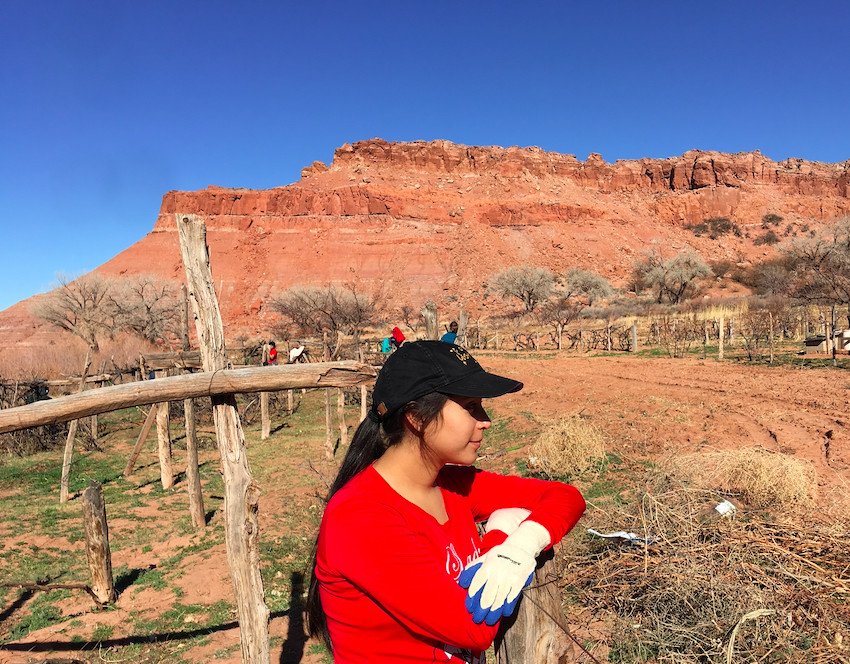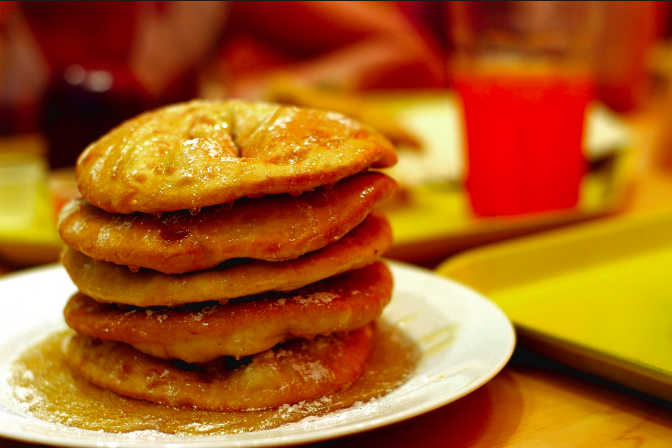Why Is The Navajo Nation Dying Out?

Podcast Transcript:
Hello beautiful humans, I hope everybody is having a great day. My Name is Rosa Venegas Hernandez and welcome to my podcast. In today’s segment, we will be talking about the Navajo language, more specifically, why the Navajo language is dying out and how this phenomenon affects the attempts to preserve the Navajo culture. Before we start I would like to add a disclaimer for anybody who is unfamiliar with the Navajo; I will be using the words Navajo and Dine interchangeably. I will also be using the words first nation, indigenous, and native people interchangeably.
Ok, so first and foremost I would like to start this podcast off by reading a quote from Buffy Sainte-Marie, a first nation musician, educator, activist, and so much more. Buffy states, “ language and culture cannot be separated. Language is vital to understanding our unique critical perspectives. Language is a tool that is used to explore and experience our cultures and the perspectives that are embedded in our cultures.”
So, this past March I had the privilege to visit the Navajo Nation, as part of my GBL 102 Journey’s trip. On the trip, we discussed the Dine culture and the social issues the Dine people encounter. In one of our discussions slash reflections after a long day of exploring, one of our Dine guides mentioned that the Navajo language is not spoken by many young people. Vanessa, our Dine guide, told us that only a small portion of the people who live on the reservation are fluent in Navajo. To her, she explained, this was dishearting because the Navajo language is closely tied with the Navajo culture. Aspects of the culture like prayer and ceremonies are done in the Navajo language. Losing the Dine language could mean the gradual loss of the Dine Culture. So, it is no wonder the Navajo language plays a key role in preserving the Navajo culture.
Curious to learn more I embarked on a journey of research. In a study I stumbled across, researchers found that only 18% of Navajo children aged 3-5 spoke the Navajo Language (Batchelder & Markel). This astounded me, but it also reminded me of the youth at home who live in a bilingual household. Many of them don’t speak proper or fluent Spanish. And I started to think: I feel connected to my culture because I know the language. This led me to the thought: language connects us to our cultures. The Navajo elders are connected to their culture through the language. The majority of youth, however, don’t speak Navajo. So then, how do they connect to their culture? More importantly, why DO so little youth speak Navajo?
In an intriguing book published by the University of Arizona Press, there is a small section that is written by Tiffany S. Lee titled “If I Could Speak Navajo, I’d Definitely Speak It 24/7.” In the section, Tiffany explains that many Dine schools do not prioritize language or cultural learning. Schools like Rock Point Community School, that teach a bilingual, English and Navajo, curriculum are rare, despite being mandated to teach the Navajo language and culture (Lee). To understand how Navajo Schools are primarily English speaking schools, we must understand the long painful history of forced assimilation. Boarding schools were designed to forcefully assimilate the Dine people into quote American culture. These boarding schools prohibited traditional Navajo clothing, ceremonies, prayer, customs, and language. These methods of forgetting were instilled in the Navajo youth who were forcibly assimilated (Todachenny). Children were punished if they spoke their language. The Navajo were taught to forget their culture and language. This created a trauma amongst the Navajo people; many parents chose not to teach their children Navajo because of this painful history and this cycle continues. Even now, the implications of forced assimilation are seen through the washing away of the Dine language, and thus culture.
While the Dine community agrees that learning the Navajo language is important for the youth, many cannot agree on who should teach the Navajo language. Many elders believe it is not the duty of the schools, this is again is likely due to the painful past of the boarding schools. While the younger adults believe the schools are responsible for teaching the language. This conflict of ideas amongst who should teach the language in of its self is a problem for the youth trying to learn Navajo. The best route to revitalize the Navajo language amongst the youth, however, is not just one method but multiple methods. Navajo should be taught and spoken at with elders, friends, in school, at home, parks, everywhere (Lee). The Navajo language should be embraced wholeheartedly by the community and the youth will follow.
You know it’s interesting how the odds have been stacked against the Dine people, yet they always find a way to prevail. And this makes me hopeful for the revitalization of the Navajo language. While researching for this podcast, I stumbled upon many initiatives to help preserve and teach the Navajo Language. Initiatives like translating “Finding Nemo” and “Star Wars” to Navajo. You know, Dulingo has a new course on Navajo. Youth like Lyla June are taking back their Native identity and with it their language. There is a push to learn Navajo and preserve the culture. This gives me hope for the future of the Navajo language and culture.
Well beautiful humans, thank you for listening to my podcast. I hope you have a wonderful day and till next time.
Todacheeny, Frank. “Navajo Nation in Crisis: Analysis on the Extreme Loss of Navajo Language Use Amongst Youth.” ProQuest Dissertations & Theses Global 76, no. 4 (October 2015).
“Is Navajo a Dying Language?” San Juan Record. March 26, 2008. http://www.sjrnews.com/vi ew/full_story/6745677/article-Is-Navajo-a-dying-language-.
Benally, AnCita, and Denis Yin. “Diné Bizuad [Navajo Language] at a Crossroads: Extinction or Renewal?” Bilingual Research Journal 29, no. 1 (Spring 2005): 85.
Bachelder, Ann, and Sherry Markel. “An Initial Exploration of the Navajo Nation’s Language and Culture Initiative,” January 1, 1997.
Lee, Tiffany S. “‘If I Could Speak Navajo, I’d Definitely Speak It 24/7’: Diné Youth Language Consciousness, Activism, and Reclamation of Diné Identity.” In Diné Perspectives: Revitalizing and Reclaiming Navajo Thought, edited by Lloyd L. Lee and Gregory Cajete, 158–69. Critical Issues in Indigenous Studies. Tucson, AZ: U of Arizona P, 2014.
Add Your Heading Text Here
 Coalmine Canyon Tuba City, Arizona March 8, 2019 Photographed by Rosa V. Venegas Hernandez
Coalmine Canyon Tuba City, Arizona March 8, 2019 Photographed by Rosa V. Venegas HernandezThis photo is of Coalmine Canyon. The sky is a true blue color with small clouds unevenly distributed in the sky. Th sunk is shinning and the sky is clear. The picture is taken from the bottom of the canyon, therefore the picture is in an upward angle. The canyon’s main color is a lite pastel brown; it has two orange stripes running across the canyon displaying the layer of sediment.
The image showcases the beauty of Coalmine Canyon, while simultaneously showing it’s ‘loneliness.” Coalmine Canyon is located in Tuba City, Arizona, which is part of the Navajo Reservation. The canyon has a rich Navajo history, yet it is often times under-appreciated by many people. Tourists tend to focus on the Grand Canyon, a beautiful place in its own right while neglecting Coalmine Canyon. While the Grand Canyon overshadows Coalmine Canyon, I have learned that the small unknown places are the most beautiful and peaceful. At the end of the day, lonely places, Coalmine Canyon, are where we go to learn more about ourselves and the world.
Food at My Global Journeys: Navajo Nation

http://www.flickr.com/photos/izik/4974426622/in/photostream/[/caption]
Frybread
Not long ago, I went to a Native American Pow Wow at Stone Mountain. My Global 102 professor, that will be conducting my Journey’s trip, also put together and conducted the Pow Wow visit as a preview to Native American culture. Going was obviously very fun and I got to try a traditional Navajo Nation food: Frybread. In my Journey’s trip, this is a dish/ specialty I hope to encounter, especially because it can be made in various forms.
Frybread is made of dough that is flattened out into a circle like shape. The dough used in frybread is made of flour, salt, baking powder, and water. The dough is often Submerged in hot shortening, oil, or other fats to bring the dough into a crispy texture. This delicacy can be served in many different ways and with many different toppings. For example, it can be served as a taco or rez burger. The way in which I had fry bread was in a dessert like style; it was topped with strawberries, sugar powder, and condensed milk.
A Brief History of Frybread: Cultural
Frybread has a long standing history in the Navajo Nation. It first appeared during the 1860s. At this time the United States government attempted to take ownership of Navajo land and therefore forced them to migrate from Arizona to New Mexico. The United States government forced the migration of the Navajo Nation through what is now known as the Long Walk of the Navajo Nation or The Long Walk to Bosque Redondo. The Long Walk was a hard 300 mile migration journey that killed many of the Navajo Nation’s people. At the same time, the United States government burned the lands of the Navajo people to force them to migrate. For four years, the Navajo people were held captive with little food. Some of the food supply they did have included flour, lard, salt, sugar, baking powder, yeast, and powdered milk, and even then these food supplies were scarce. It is no wonder now, that the scare ingredients provided to the Navajo people by the United States government resulted in the creation of the frybread. Now, the frybread is a symbol of triumph to the Navajo Nation, as they survived the long torture imposed on the nation by the American government. It is now a symbol of pride and honor in the Navajo Nation. The frybread continues to evolve and immerse itself in other Native American cultures, such so that the frybread is a staple piece at Pow Wows.
Socioeconomic Perspective
Native Americans have some of the lowest unemployment rates in the country. Due to the lack of access to resources many reservations cannot support the inhabitants of the reservation. Time and time again American policy continues to fail the Natives of this land. About 28.4% of Native Americans live in poverty in reservations. It is no surprise then, that the most common food ate in reservations are the ones with simple, cheap, easy to come by ingredients. The frybread continues to thrive and spread in many Native communities because of how cheap and easily made it is. The frybread allows low-income communities and families to feed its members without sacrificing other necessities in the process. It is no wonder that the frybread continues to grow and expand amongst the native community.
Sources
https://whatscookingamerica.net/History/NavajoFryBread.htm
https://www.smithsonianmag.com/arts-culture/frybread-79191/
https://www.globalhealingcenter.com/natural-health/how-unhealthy-is-white-flour/
http://indianyouth.org/american-indian-life/poverty-cycle
https://en.wikipedia.org/wiki/Reservation_poverty
